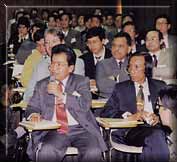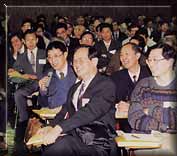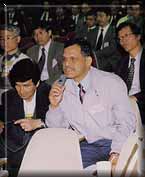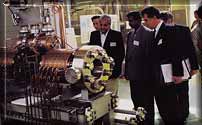First Asian Particle Accelerator Conference “APAC98”
Four hundred people got together at KEK on March 23 - 27, 1998, to participate in the
First Asian Particle Accelerator Conference, “APAC98”. It was a big success, and without doubt, will be remembered among the Asian accelerator science community as a memorable
event in its history.

The accelerator science and technology in the Asian region is not new. Low energy accelerators
like high-voltage generators, electron linear accelerators and cyclotrons have been quite common in many Asian countries. This situation changed very much in 1980's, when synchrotron radiation become a worldwide hit. Asian region was not an exception to this and has taken a lot of interests in the development of synchrotron radiation sources. Synchrotron radiation, being a very bright source of light from ultra-violet to x-rays, has attracted scientists in the fields of physics, chemistry, biology, and medicine. Many light sources were constructed and some are being planned in the Asian region. Asian Committee for Future Accelerator (ACFA) was formed in April, 1996 to promote mutual understanding of activities and to strengthen the international collaboration among the Asian regions. The first ACFA meeting was held in Pohang, Korea where the Pohang Light Source is located. At the meeting, ACFA decided to regularly hold Asian Particle Accelerator Conference (APAC) and to have the first conference in Tsukuba, Japan in March, 1998.
The first day was for the reports from each country and region on their activities. The speakers were Shuxian Fang (China), S. S. Kapoor (India), A. Djaloeis (Indonesia), M. Inoue (Japan), Won Namkung (Korea), Swee- Ping Chia (Malaysia), Richard Sah (Taiwan), Weerapong Pairuswan (Thailand) and Van-Do Nguyen (Vietnam). Invited talk from Novosibirsk was presented by I. Chatounov in place of A. N. Skrinsky.
 Electron-Positron Collider
Electron-Positron Collider
From the area of high energy physics, the activities of the Beijing Electron-Positron Collider and the KEK B-factory were reported. The B factory is a new electron-positron collider being constructed at KEK which is now in the final stage of construction. Among the next generation high energy accelerator concepts, linear colliders have been the most seriously considered. Linear colliders (which produce head-on collisions of electrons and positrons accelerated by linear accelerators of about 20 kilometers in length) are technically very challenging and status reports were presented by KEK, SLAC, DESY, and BINP.
High-intensity proton accelerators
Interests in high-intensity proton accelerators have grown in Asia. Major reasons are for; the production of high-intensity neutrons for basic materials research and the development of advanced nuclear power technologies for accelerator-driven nuclear waste transmutation and power production. Reported were; the Neutron Science Project by JAERI, the Japan Hadron Facility project proposed by KEK and KOMAC Project (Korean Multipurpose Accelerator Complex) by KAERI. Both the JAERI and the KOMAC designs incorporates a super-conducting linear accelerator at around 1 GeV with very novel technology. The KEK proposal applies a cascade of two synchrotrons with the energy of 3 GeV and 50 GeV.
 RI beam (RIB) factories
RI beam (RIB) factories
Since the invention of a cyclotron in 1932, many were constructed for nuclear physics at first and then for medical applications in recent years. A noticeable advancement in this area is the construction of RI beam (RIB) factories. RIB (accelerated unstable nuclei produced by cyclotrons) have very attractive properties not only for nuclear physics but also for materials science and for medical applications. In Asia, two facilities have been operating: Institute of Modern Physics in China and RIKEN (The Institute of Physical and Chemical Research) in Japan. An approval of a new RIB Factory project at RIKEN was reported by Y.Yano. When completed, it will be the most powerful RIB factory in the world.
 Synchrotron radiation
Synchrotron radiation
Synchrotron radiation and free-electron lasers also attracted scientists. Many light sources as user facilities exist in Asia; two in China, one in India, three in Japan, one in Korea and one in Taiwan. The Siam Photon project in Thailand has already been approved and as Hongjie Xu from Shanghai Synchrotron Radiation Facility (SSRF) Project reported, the SSRF project has finished the R&D stage and is waiting for the final approval for construction.
Low-or medium-energy accelerators
Low-or medium-energy accelerators and their uses were also important subjects at the APAC. Examples of their applications are the medical applications such as cancer therapy and isotope production. Recently, proton or heavy-ion therapy has been developed and several such facilities have been constructed at hospitals in Japan. Plans for such facilities exist in China, Korea and Taiwan as well. Materials microanalyses are also classical techniques using low-energy accelerators. An interesting application is related to environmental problems. Accelerator mass spectrometry technique has been widely applied to detect an extremely small amount of elements contained
in our environment.
 Compact electron linear accelerator
Compact electron linear accelerator
Another interesting development reported at the conference was a very compact electron linear accelerator which uses very high microwave frequency for baggage inspection at airports. The conference program included 24 oral and 200 poster presentations besides the invited talks.
And...
A KEK tour provided opportunities for onlocation discussions between the participants and KEK staffs which was very fruitful for younger participants in particular. Evenings were also quite lively at parties and a banquet which further helped the participants to get to know each other well.
The third ACFA meeting was held on March 25, where Zhipeng Zheng of IHEP (China) and Won Namkung of POSTECH (Korea) were elected as the next chairperson and the vice-chairperson. Next ACFA secretaries will be Shu-hong Wang of IHEP and In- Soo Ko of POSTECH. We look forward to the next APAC in China.
